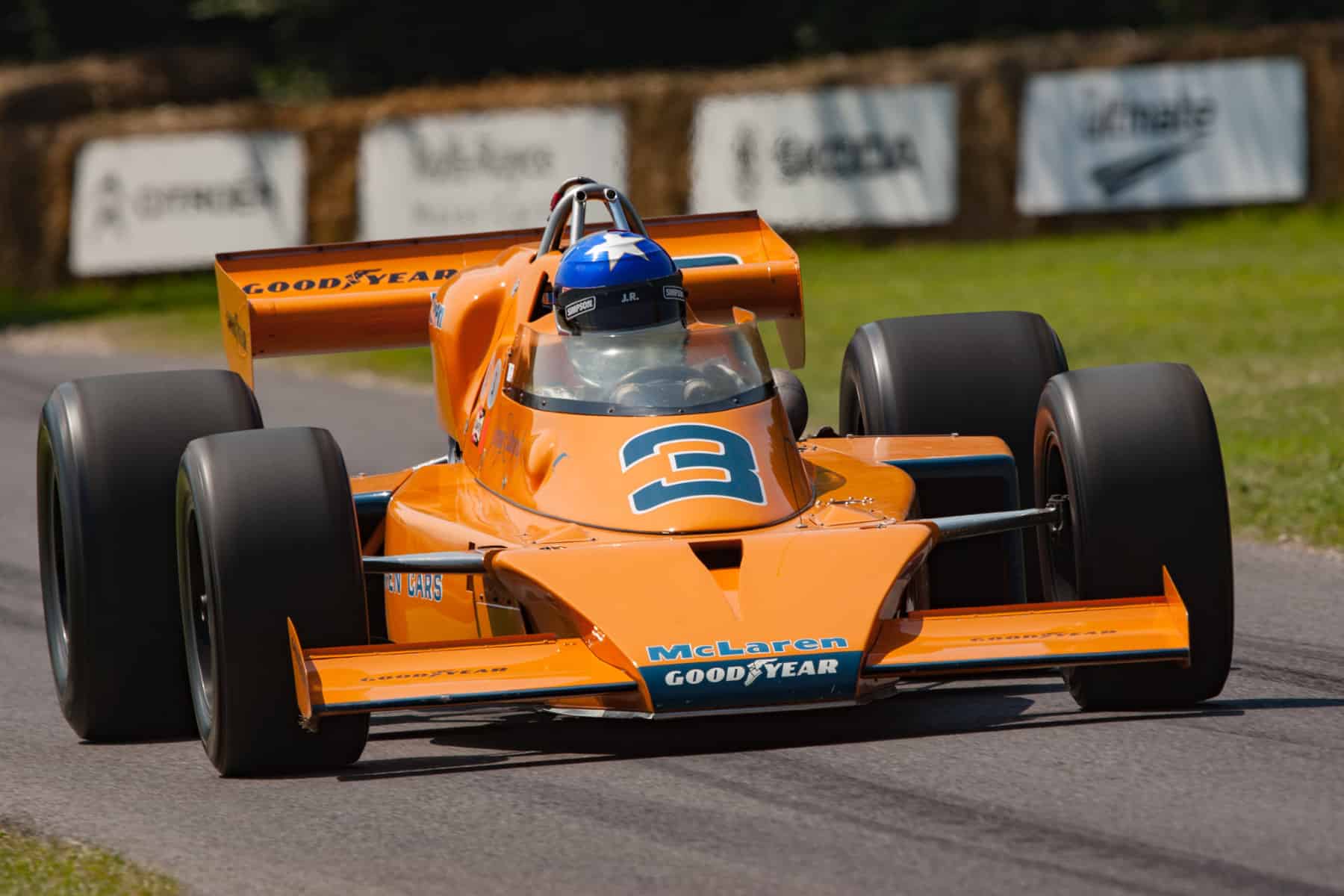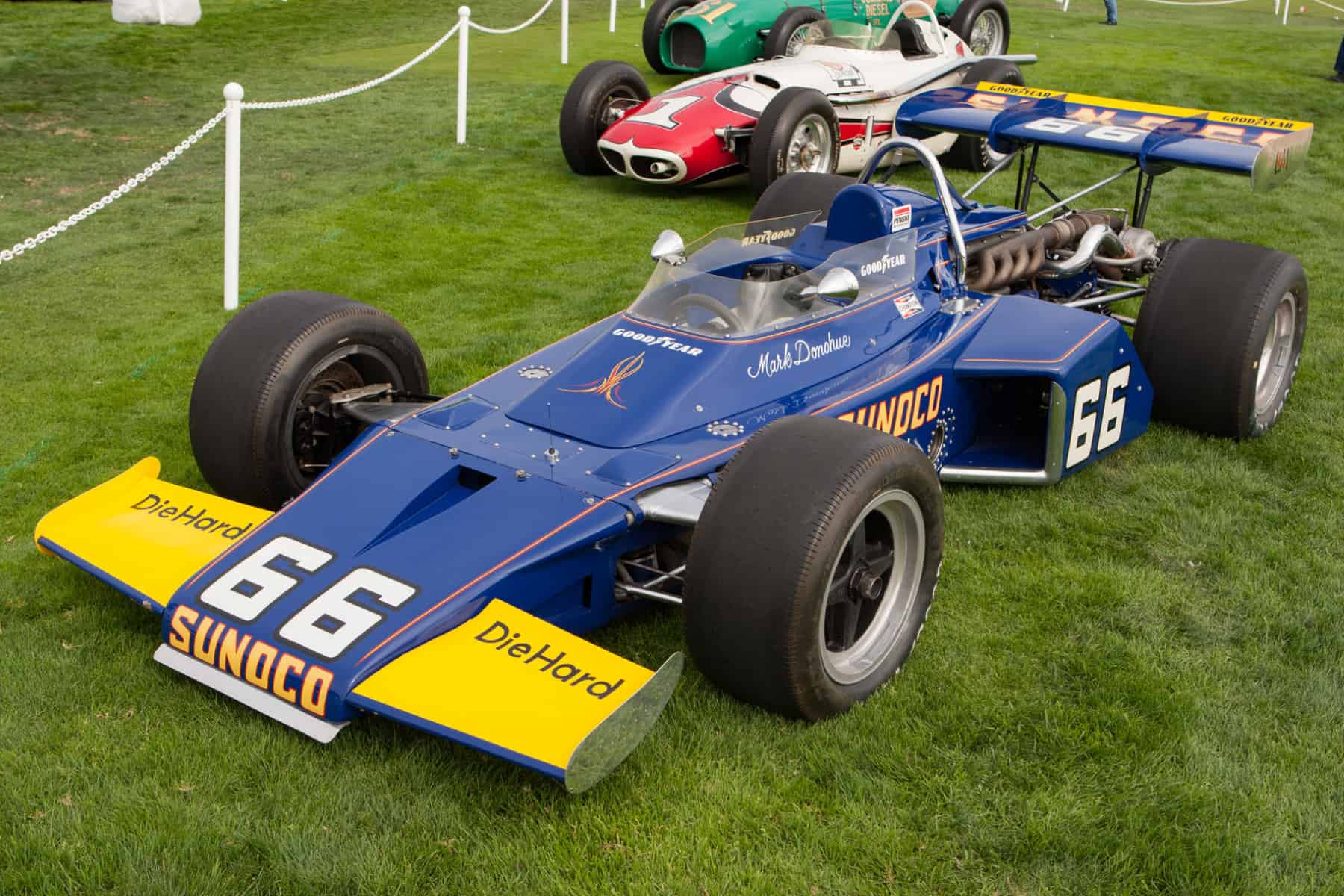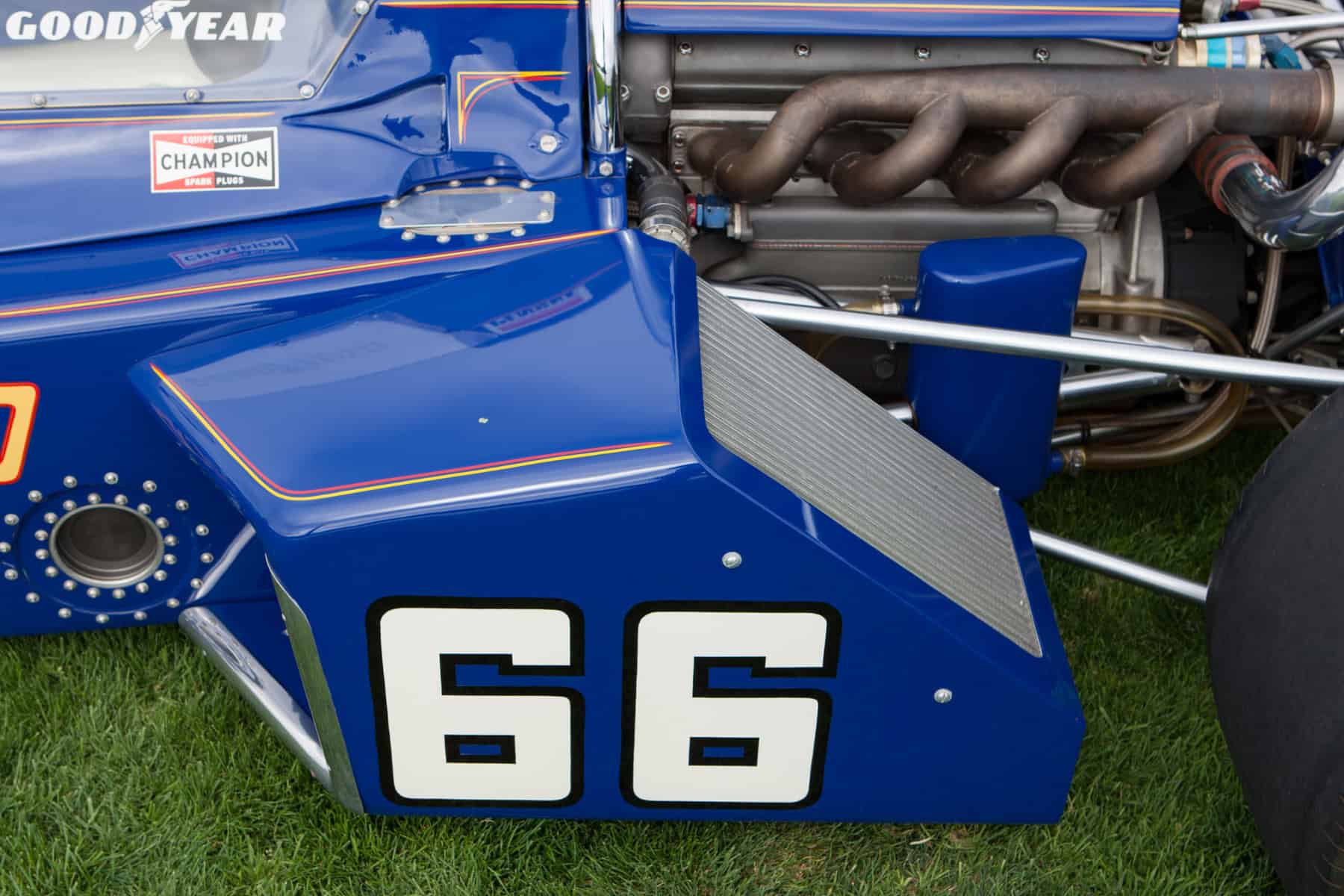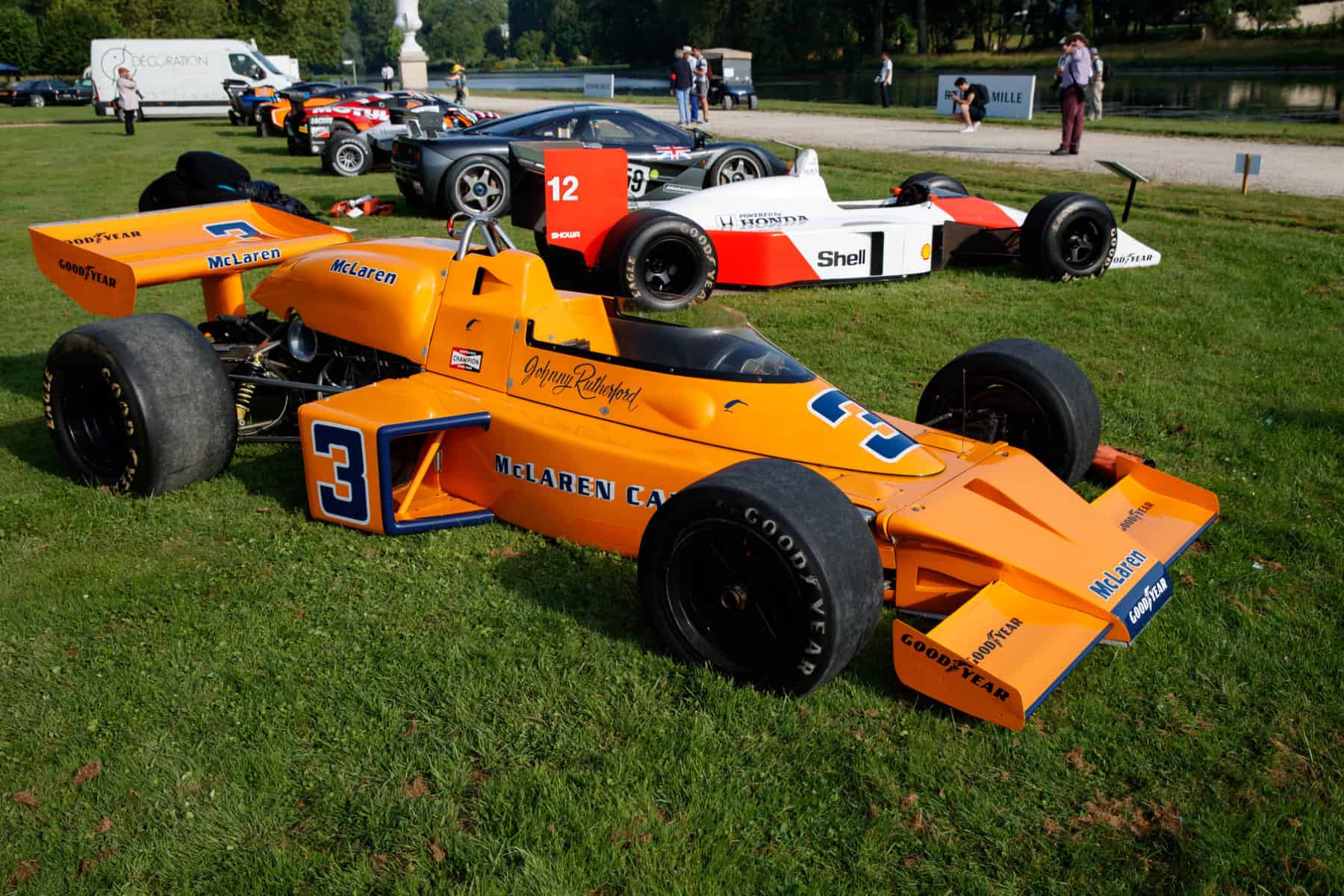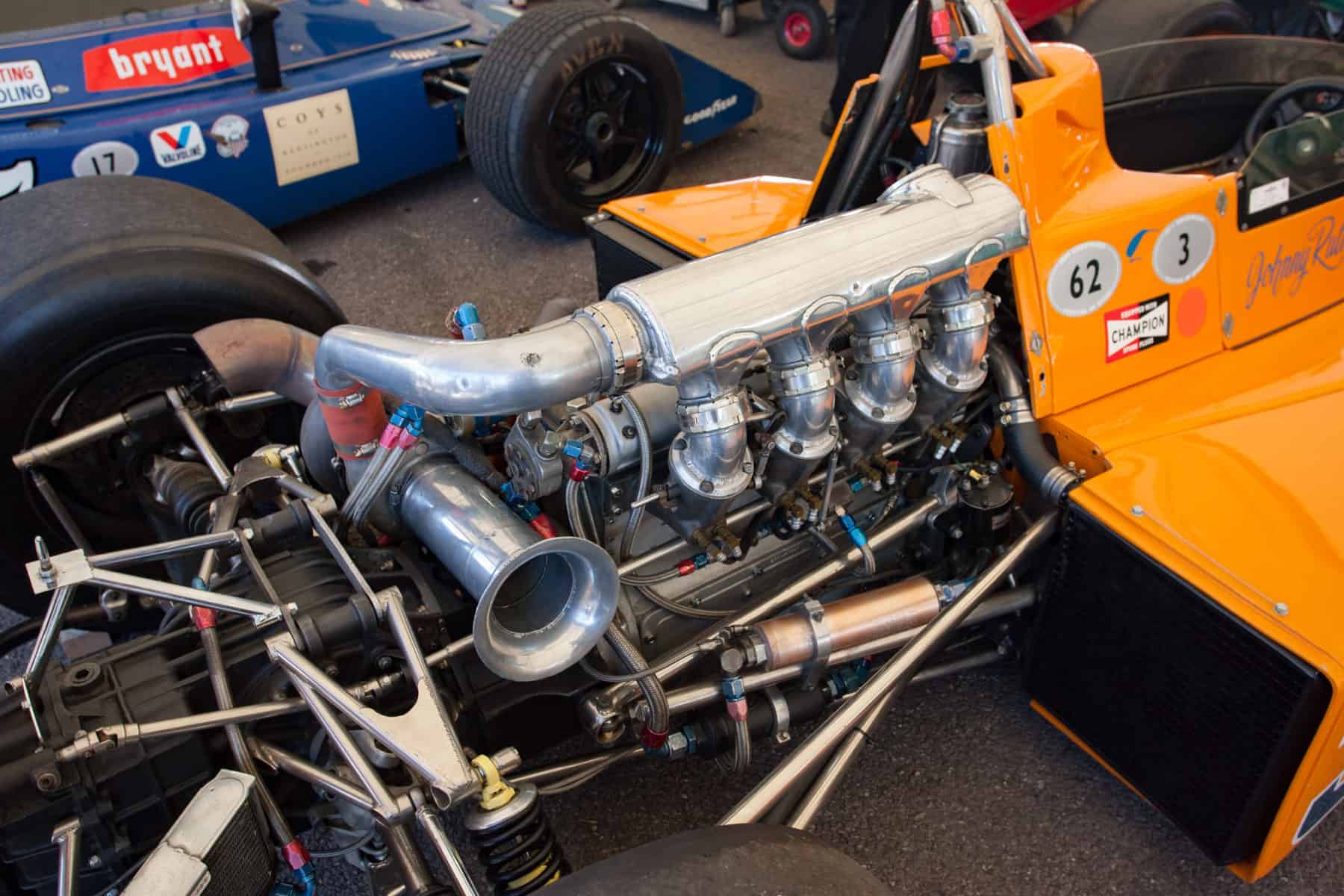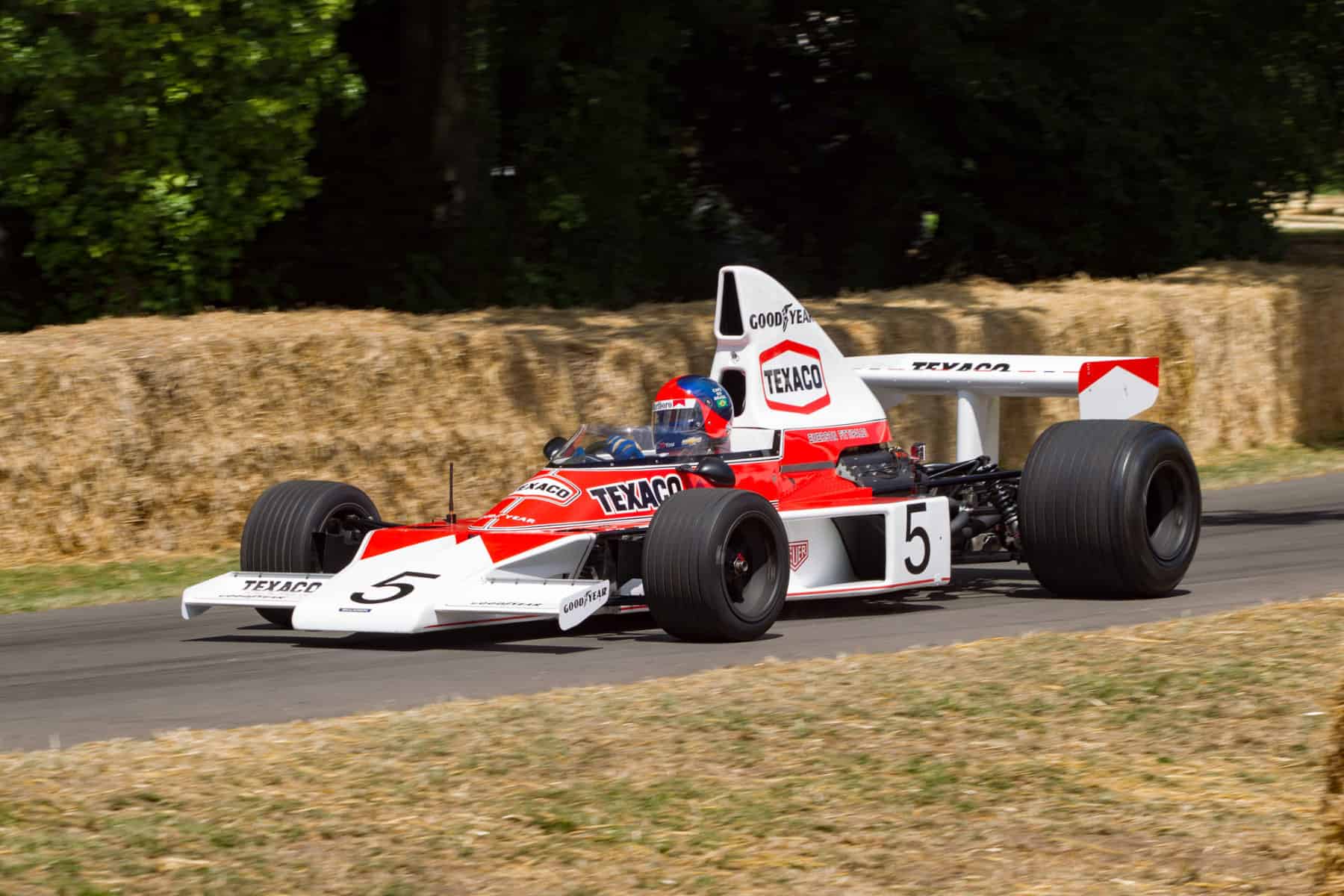McLaren M16
Out of tragedy arose one of the all-time great racing car designs
BY: WOUTER MELISSEN
At the start of the 1970 season, the Bruce McLaren Motor Racing team were ready for an additional challenge. The team’s drivers, Bruce McLaren and Denny Hulme, had won every round of the 1969 Canadian-American Challenge Cup in a McLaren M8 and the talented pairing had also scored four Grand Prix victories during the 1968 and 1969 seasons with the McLaren M7. The new challenge planned for 1970 was a stab at the very lucrative Indy 500.
For the tentative first outing at oval racing, designer Gordon Cuppock drew on what he already knew and based the new McLaren M15 on the successful Can-Am racers. This was deemed a more suitable base to cope with the heavy loads the car was expected to endure during the Indy 500 than the more delicate Formula 1 cars. The sturdy aluminum monocoque was relatively wide and used to A-frames aft of the rear bulkhead to house the Offenhauser four-cylinder engine. Much of the suspension came directly from the M8 parts bin. The radiators were mounted in the nose of the car with the fuel tanks located inside the monocoque chassis on either side of the engine. Finished in the team’s familiar “Papaya Orange,” the new M15 also boasted a rear wing.
While both McLaren and Hulme had a go with the M15 during test sessions, the team boss returned home to England to help develop the latest M8 for the upcoming Can-Am season and Hulme was joined by Chris Amon for the Indy 500. Amon quickly discovered oval racing was not for him and he asked to be replaced. Hulme also stepped down after he had been badly burned when one of the quick-release caps had come loose. Their places were taken by Peter Revson and Carl Williams. Revson ran well until a mechanical issue forced him to retire. Williams did finish the race, in a commendable ninth. Later in the year, Revson led the California 500 until the final pit-stop when his engine failed to start and he dropped to fifth.
For what was their first go at American single-seater racing, the McLaren team did remarkably well. However, in June 1970, founder Bruce McLaren fatally crashed while testing the new M8D – a little over a week after the team had made their Indy 500 debut. Nothing was certain now for the fledgling racing car manufacturer. Although McLaren was just thirty-two years old at the time of his passing, he had been the driving force behind his team as a driver, engineer, and team principal. The New Zealander left impossibly big boots to fill but his team showed a resilience that was both inspiring and a fitting testament to McLaren. His long-time right-hand man, Teddy Mayer, took over as team leader, and despite his heavy burns, Hulme persevered to win another Can-Am title for McLaren. Amid all this turmoil, Gordon Cuppock created what would be one of the most influential and successful racing cars of all time.
Dubbed the McLaren M16, the 1971 Indy racer was once again built around a sheet aluminum monocoque. This design featured three structural steel bulkheads; one ahead of the front suspension, one at the driver’s knees that also formed the dashboard, and one at the rear of the monocoque. The aluminum alloy sheets were riveted to the three bulkheads to form a lightweight and very strong structure. Two Goodyear-supplied rubber fuel bags were placed inside the monocoque, one on either side of the driver, that could hold up to seventy-five U.S. gallons of methanol fuel. Refueling was allowed and, for the Indy 500, cars were expected to make three fuel stops. As on the M15, a pair of tubular A-arms were bolted to the rear bulkhead to support the engine and gearbox.
Compared to the cutting-edge monocoque chassis, the car’s Offenhauser engine may have seemed a relic, but it was extremely effective; its design could be traced back to a marine engine that had been designed by Fred Offenhauser and Harry Miller in 1930 and had not changed much since the 1940s. In the configuration used by McLaren in 1971, the twin-cam, four-cylinder engine displaced 159 cu inches, or 2.61 liters. It was equipped with Hilborn fuel-injection and a single Garrett turbocharger. Despite running with a 24.6 psi boost limit, the Offenhauser produced well over 700 hp on methanol. The very potent “four” was mated to a Hewland gearbox. Whereas most teams fitted just two forward gears, McLaren opted to run their gearbox with three.
There was a distinct wedge shape to the chassis. Coppuck had clearly been inspired for this configuration by the 1970 Formula 1 World Championship–winning Lotus Type 72. This design was made possible by relocating the radiator – instead of using a single radiator mounted in the nose, the M16 had two smaller radiators mounted in “side-pods” on either side of the monocoque. This layout did away with much of the plumbing needed to run coolant to and from the front-mounted radiator, and also improved the weight balance. In order to ensure that sufficient fresh air reached the radiators, the front springs and dampers were moved out of the airflow and mounted in-board. The springs and dampers were actuated by cantilever-shaped rockers.
One of the main reasons for removing the radiator from the nose was for aerodynamic efficiency. The sharp nose cone fitted to the M16 also produced some downforce. Regulations restricted the use of the separate rear wing commonly used in Formula 1; Coppuck circumvented the regulations by fitting an engine cover that included what could hardly be mistaken for anything but a rear wing. As the wing formed an integral part of the bodywork, the rule makers could do little but approve its use. It was a crucial part of the design as the nose produced so much downforce that the rear wing was needed for aerodynamic balance. Additionally, small winglets were fitted on either side of the nose cone, which served mainly to further trim the aerodynamics.
The M16 was first shown to the gathered press at the Colnbrook factory in January of 1971. A works effort was announced with Denny Hulme and Peter Revson as the drivers. In addition, a third car was sold to Team Penske after Roger Penske and driver Mark Donohue saw the M16 at a social visit to the McLaren factory. The two were actually in England to take a look at rival Lola’s new Indy car. Penske and Donohue were so impressed with what they saw in Colnbrook that they opted to acquire a McLaren M16 instead. Not only was this a welcome sale, but having such an experienced team on-board to help develop the car proved invaluable.
Having briefly tested the first M16 at the Ontario Speedway in California, McLaren handed the car to Team Penske. Donohue first drove the car at Indianapolis in March, immediately lapping at 172 mph. After further development, the Sunoco-liveried machine ran at a staggering 180 mph average. For the race itself, it was Revson in one of the orange works cars that grabbed pole position with Donohue qualifying in second and Hulme in fourth. In the race both Donohue and Hulme retired. Revson did finish, in second, after inexplicably failing to mount a late challenge to the Johnny Colt Lightning Ford of eventual winner Al Unser Sr. Later in the season, Donohue scored the first Indy racing victories for McLaren by winning at Pocono and Michigan.
Over the winter, the car evolved into the M16B with revisions mainly made to the aerodynamics. The nose was shortened slightly while a proper rear wing was now fitted. Brand-new cars were built for the 1972 season, of which two were sold to Team Penske for Mark Donohue and new signing Gary Bettenhausen. Dan Gurney’s Eagle team had also caught on and produced a wedge-shaped car of their own, raising the level of competition considerably. Bobby Unser qualified on pole position with one of the new Eagles at a mesmerizing 196 mph average. In the race both McLaren’s Revson and Unser retired early on. Penske had sent Donohue out on a conservative strategy, which helped him score both Team Penske’s and McLaren’s first Indy 500 victory.
For the McLaren team’s Formula 1 cars, Coppuck had retained a more conservative approach through the 1971 and 1972 seasons with little luck. The design was abandoned and for 1973 Coppuck created what was effectively a Formula 1 version of the M16 Indy car. Named the M23, it was slightly smaller but followed the same wedge-shape design with side-pod mounted radiators. It used the Cosworth DFV V8 and Hewland gearbox as full stressed units. McLaren would go on to use the M23 well into the 1977 season. In 1974, it was used by Brazilian Emerson Fittipaldi to win the team’s first Driver’s and Constructor’s World Championships. Still competitive two years later, it was also used by James Hunt in his epic battle with Ferrari’s Niki Lauda. Hunt added another title to the M23’s tally, which also included sixteen Grand Prix victories.
Having spawned a successful Grand Prix counterpart, the M16 continued to be developed. In what remained a fascinating battle with the Roman Slobodynskyj-designed Eagles, Gordon Johncock won for Dan Gurney in 1973 but McLaren bounced back in the following season with the M16C/D. With Johnny Rutherford at the wheel, it was now a Papaya Orange McLaren works car that scored the constructor’s second Indy win. In 1975 an Eagle, this time driven by Bobby Unser, was in victory lane again. For the M16, the swan song came in the ultimate “E” configuration with which Rutherford managed to score McLaren’s third Indy 500 victory in five attempts.
For 1977, the M16 was finally superseded by the M24, which in many ways was a M23 with the new Cosworth DFX V8 engine bolted to its rear bulkhead. Although McLaren ended its works effort at the end of the 1979 season, privateers continued to campaign M16s and M24s for some years to come. Mario Andretti was a much-disputed second in the 1981 Indy 500 behind Bobby Unser, who was initially disqualified only to be reinstated after an appeal nearly five months later. McLaren would eventually return to Indy but as an entrant during the 2010s, running a spec Dallara like the rest of the field. At the end of the month, the Arrow McLaren SP team will field three cars in the 2021 edition of the Indy 500.
With three Indy 500 victories in a highly competitive era, on its own accord the M16 is already one of the most successful competition cars of all time. Considering that it also spawned a two-time World Championship and sixteen-time Grand Prix winning machine truly makes it one of the all-time great racing cars.
